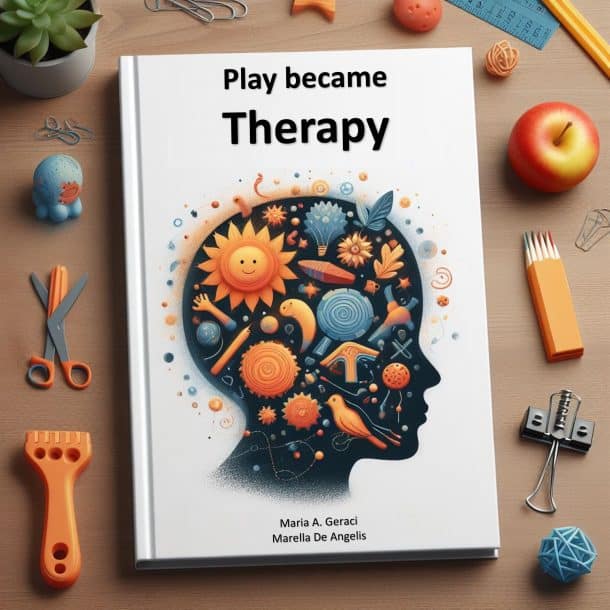HOW DIRECTIVE PLAY THERAPY HELPS CHILDREN
DEFINITION PLAY THERAPY DIRECTIVE
Directive Play Therapy uses play to create a strong bond between therapist and child, fostering meaningful experiences. In fact, play represents the innate language of childhood and plays an adaptive and structuring role as the child grows. Through play, the child can express his thoughts, emotions and needs, and the therapist can help him process his difficulties and promote his well-being.
The roots of play in therapy: the main directive methods
The Play Therapy Directive is inspired by several theoretical and clinical currents that have recognized the value of play as a therapeutic tool. Among them, we can mention:
PSYCHOANALYTIC PLAY THERAPY
Is based on the theories of Sigmund Freud, Melanie Klein and Anna Freud, and which uses play as a means of accessing the child’s unconscious contents and interpreting and resolving them.
RELATIONS THERAPY
Is based on the theories of Donald Winnicott, and which uses play as a means to ease the transition between the child’s inner world and external reality, and to strengthen the relationship with the therapist.
COGNITIVE BEHAVIORAL PLAY THERAPY
Which is based on the theories of cognitive-behavioral therapy, and uses play as a means to teach the child new skills, strategies and ways of thinking, and to modify his or her dysfunctional behaviors.
SAND PLAY THERAPY (THE WORLD TECHNIQUE)
This approach was introduced by Margaret Lowenfeld in the 1920s and is also called “Sand Play.” The purpose of this technique is to overcome the limitations of verbal psychoanalytic therapy and allow the child to express thoughts and emotions that cannot be communicated through words.
According to Lowenfeld, the need to make sense of experience is present from early childhood but is expressed through images. Children are given sandboxes and shelves with miniaturized, realistic objects. Next, they are encouraged to create a three-dimensional image of their world in the sand.
Lowenfeld believed that the world created by each child reflected his or her problems, and that by commenting on the play, children could express their emotions and become aware of them (nonverbal thinking) (Lowenfeld, 1950). Although the technique is clearly based on psychoanalytic principles, some elements recall the nondirective approach, for example, the therapist’s comments are descriptive and not interpretive
NARRATIVE PLAY THERAPY
Narrative Play Therapy has its roots in the writings of Ann Cattanach and is based on a model of play therapy that has been influenced by drama therapy and other forms of art therapies. The focal points are the conception of storytelling in relation to the psychology of the self, developmental research on storytelling and play, and the use of story to construct shared meaning (Cattanach 1997, 1999).
Stories and narratives produced in play and constructed together with the therapist are the fundamental elements of the therapeutic process, as well as being agents of change. Shared construction can help to place the story in a larger context, allowing the child to gain a more expansive view, which is also facilitated by the consideration of different endings, the resolution of misunderstandings in storytelling and retelling (McLeod 1997).
Narrative Play Therapy is based on the idea that stories can help children make sense of their experiences, explore their identities, express their emotions, resolve their conflicts, and imagine new possibilities. In addition, the therapist can use stories to convey positive messages to the child, to encourage them to experiment with new roles, and to stimulate their creativity.
RELEASE THERAPY
This form of therapy through play was devised in America by David Levy in the 1930s. It is a therapy aimed at the “release” of emotional tension, designed to assist children who have experienced a particularly painful or traumatic event to manage the emotions related to it.
In fact, the goal is to use play as a tool to recreate stressful situations, with the intent of releasing the child from associated negative emotions. It is based on the psychoanalytic concept of repetition compulsion, according to which, through reinterpretation and experiencing a specific event, repressed or blocked emotions are released and eventually processed (Levy, 1938).
Gove Hembridge (1955) extends Levy’s work to employ his method in the clinical field, primarily to address problems associated with trauma. The therapist takes a more guided role and deals with reconstituting conflict situations, then allowing the child to interact freely with those contexts.
ADLERIAN PLAY THERAPY
Adlerian play therapy is a therapeutic technique and approach, of individual psychological origin, that makes use of play in treatment with the child.
According to Terry Kottman (2001), there are four important moments in Adlerian-oriented play therapy. The first moment is to create a cooperative, equal and emotional relationship with the child.
The second moment is to explore the child’s way of life through play. The third moment consists of helping the child understand himself better. The fourth moment consists of guiding and re-educating, providing opportunities to try new ways of interacting.
Play is considered the preferred means of accessing child inquiry and intervention. Through play, the therapist can project in a purposeful way on the child’s structure up to that point, not just as a reflection of the internal world absorbed in past experiences. The goal of play is thus closely related to the possibility of exploring the “unknown” and developing both emotional-experiential and cognitive knowledge.
The therapist directs the child toward constructive goals through incitement, empowerment and relationship building.
PRESCRIPTIVE PLAY THERAPY
Heidi Gerard Kaduson, Donna Cangelosi and Charles Schaefer (1997, 2019) first introduced the concept of prescriptive play therapy. They argue that rigid adherence to a single theory may not be effective in treating children, thus suggesting the use of various constructs. The therapist should possess expertise in more than one theoretical orientation and in various play therapy techniques, both directive and non-directive. In addition, he or she should be able to adapt a specific intervention to his or her personal style, showing flexibility and skill.
How Directive Play Therapy Works
Directive Play Therapy differs from Non-Directive Play Therapy in the more active and guiding role of the therapist, who chooses play activities best suited to the child and his or her therapeutic goals, and intervenes with suggestions, questions, feedback, and reinforcement. In addition, the therapist may involve parents or other family members in play to improve the quality of family relationships and to encourage generalization of changes to the child’s life context.
The Play Therapy Directive takes place in a room equipped with various materials and toys, which stimulate the child’s creativity, imagination and expression. The therapist observes the child as he plays and interacts with him, trying to understand his inner world and help him resolve his conflicts and fears. In addition, the therapist helps the child develop his cognitive, emotional, social and communication skills, and strengthen his self-esteem and sense of efficacy.
What are the benefits of Directive Play Therapy
Directive Play Therapy can bring numerous benefits to the child and his or her family, including:
- Improving understanding and acceptance of self and others
- Promoting the expression and regulation of emotions
- Reducing symptoms and problem behaviors
- Developing new skills and coping strategies
- Enhance resources and strengths
- Increase motivation and enjoyment of learning
- Strengthen relationship with therapist and parents
- Improve quality of life and psychological well-being

Who Directive Play Therapy is for?

Directive Play Therapy is indicated for children between the ages of 3 and 12 who have emotional, behavioral, relational or learning difficulties, or who have experienced traumatic or stressful experiences. Among the problems that can be treated with Directive Play Therapy are:
- Anxiety, phobias, shyness, inhibition
- Depression, sadness, apathy, withdrawal
- Aggressiveness, oppositionality, impulsivity, hyperactivity
- Attention and concentration disorders
- School difficulties, specific learning disorders
- Low self-esteem, low self-confidence
- Relationship difficulties with peers, isolation, bullying
- Relationship difficulties with parents, family conflicts, separation or divorce
- Bereavement, loss, abandonment
- Abuse, mistreatment, violence, neglect
- Chronic illness, disability, hospitalization
How to learn more about Directive Play Therapy
If you are a child psychologist and want to learn more about Directive Play Therapy, you can check out CBPT.org, where you will find information, articles, courses and resources useful for your training and professional practice.
REFERENCES DIRECTIVE PLAY THERAPY
- Cattanach, A. (1997). Children’s Stones in Plav Thera~y. London: Jessica Kingsley Press.Cattanach. A. (1999). Co-constmction in Play Therapy. In A. Cattanach (ed.) Process in the Arts Therwies. London: Jessica Kingsley Press.
- Freud S (1909) Two case histories: “Little Hans” and the “Rat Man”. The Standard Edition of the Complete Psychological Works of Sigmund Freud. Volume X. Published 1955. The Hogarth Press, London (Reprinted 2001, Vintage Publishers)
- Freud, A. (1946). The psychoanalytic treatment of children. London: Imago.
- Hambridge, G. (1955). Structured Play Therapy. American Journal of Orthopsychiatry, 25, 304-310.
- Kaduson, H. G., Cangelosi, D., & Shaefer, C. E. (2019). Tailoring Interventions for Specific Childhood Problems. Guilford Publications.
- Kaduson, H. G., Cangelosi, D., & Shaefer, C. E. (Eds). (1997). The playing cure: Individualized play therapy for specific childhood problems. Northvale, NJ: Jason Aronson.Klein, M. (1932). The psycho-analysis of children. London: Hogarth Press
- Knell, S. (1993). Cognitive-behavioral play therapy. Northvale, NH: Jason Aronson.
- Knell S. (1998) Il gioco in psicoterapia : nuove applicazioni cliniche, Edizione italiana a cura di Francesca Pergolizzi McGraw-Hill Companies
- Kottman, T. (2001), Adlerian Play Therapy, Int. J. Play Therapy, 10 (2)
- Levy, D. (1938). Release therapy for young children. Psychiatry
- Lowenfeld, M. (1950). The nature and use of the Lowenfeld World Technique in work with children and adults . The Journal of Psychology.
- McLeod, John. (1997) Narrative and Psychotherapy, SAGE Publications
- Shaefer, C. E. & Drewes, A. A. (2013). The therapeutic powers of play: 20. core agents of change (2nd ed.) Hoboken, NJ: Wiley.
- Shaefer, C. E. (1993). The therapeutic powers of play. Northvale, NJ: Jason Aronson.
- Taylor de Faoite, A. (2011). Narrative Play Therapy: Theory and Practice. Jessica Kingsley Publishers.
- Winnicott D. W. (1971) Playing & Reality. Tavistock Publications

